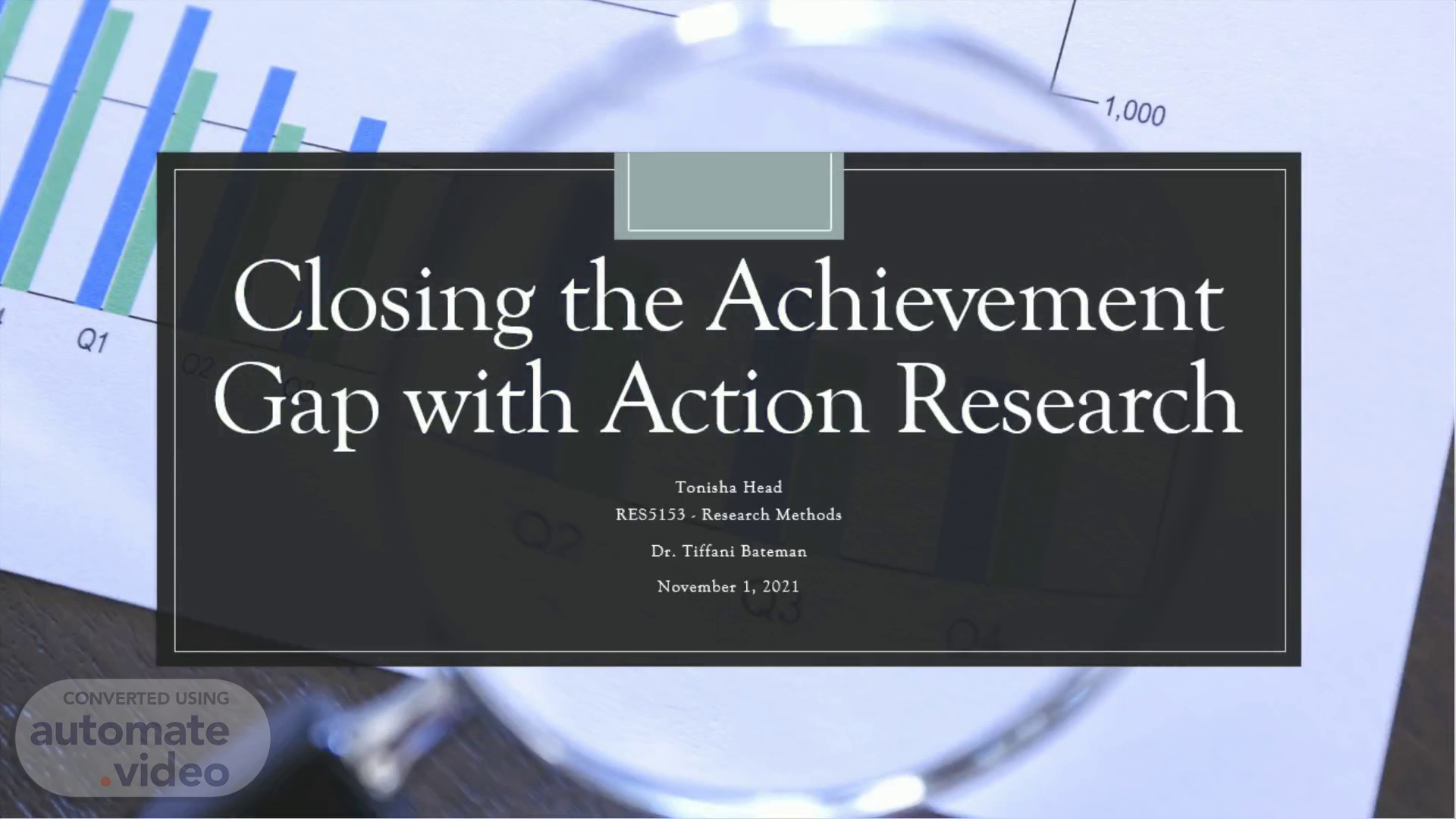
Closing the Achievement Gap with Action Research
Scene 1 (0s)
Magnifying glass showing decling performance. Closing the Achievement Gap with Action Research.
Scene 2 (11s)
Free photo: School, Lockers, Hallway - Free Image on ....
Scene 3 (34s)
Problem. The average Black male students’ engagement, grades and assessments scores are lower than other subgroups (their counterparts – Black females, Hispanic males and females, other) in my classroom..
Scene 4 (47s)
Goal. The goal of this action research is to discover effective techniques that will help to close the achievement gap between Black male adolescent students in my classroom and their counterparts..
Scene 5 (1m 0s)
Research Questions. How does the Black male adolescent students’ families, culture, and communities affect their academic achievement? How does real-life connections through instruction affect the learning of Black male adolescent students? How does culturally centered instruction affect the learning of Black male adolescent students?.
Scene 6 (1m 16s)
Books. There are several factors contributing to the perceptions of academic achievement and educational opportunity. These factors can have a negative or positive effect. Individual Personal aspirations Level of commitment to school Parent involvement/expectations School Student-teacher relationships School climate curriculum Community Neighborhood safety - St. Mary et al., (2018).
Scene 7 (1m 34s)
Books. Discourse of deficiency and rejection need to move to achievement discourse. Discourse of Deficiency: Black students’ “lower” academic performance were attributed to higher rates of poverty. Discourse of Rejection: Black male students reject academic achievement because it is onside of cultural norms. Discourse of Achievement: What theories and effective classroom practices Would help to eliminate the achievement gap, negatively impacting Black students? - Stinson (2006).
Scene 8 (1m 56s)
Books. Culturally relatable content and real-life connections enhance student motivation and achievement. - Ellis (2020).
Scene 9 (2m 6s)
Student Surveys. Ten students were given student surveys. Five Black male students considered academically “successful” and five Black male students considered academically “unsuccessful.” They were asked positively framed statements about their supports, how they feel about school and academic achievement..
Scene 10 (2m 21s)
Strongly Disagree Statement 1 Statement 2 Statement 3 Statement 4 Statement 5 Statement 6 Statement 7 Statement 8 Statement 9 Statement 10 1 1 1 Disagree Statement 1 Statement 2 Statement 3 Statement 4 Statement 5 Statement 6 Statement 7 Statement 8 Statement 9 Statement 10 2 1 1 2 3 1 2 2 2 2 Neutral Statement 1 Statement 2 Statement 3 Statement 4 Statement 5 Statement 6 Statement 7 Statement 8 Statement 9 Statement 10 2 2 3 2 1 2 2 3 1 Agree Statement 1 Statement 2 Statement 3 Statement 4 Statement 5 Statement 6 Statement 7 Statement 8 Statement 9 Statement 10 1 1 1 1 2 1 2 Strongly Agree Statement 1 Statement 2 Statement 3 Statement 4 Statement 5 Statement 6 Statement 7 Statement 8 Statement 9 Statement 10 1 1.
Scene 11 (3m 16s)
Student Surveys’ Analysis. The “unsuccessful” students’ self-rates varied more frequently The “successful” students’ self-rates were more similar, generally statements varied in the level of agreeance. The “successful” students agreed with the statements of the survey fifteen times more than the “unsuccessful” students. The “unsuccessful” students disagreed with the statements 2 1/3 times as much as the “successful” students. “Successful” students were found to have more positive connections to school and academic achievement through their majority agreeance to the positively framed statements of the survey. “Unsuccessful” students struggled with making positive connections to school and academic achievement, with the high number of neutral self-rates and 1 – self-rates (strongly disagree)..
Scene 12 (3m 47s)
Teacher Interviews. Six upper elementary Math and Reading teachers were selected for the sample, three Math teachers and three Reading teachers. Participants levels of experience, ages, genders, and races varied. The following interview questions were asked:.
Scene 13 (4m 29s)
Teacher Interviews’ Analysis. Most teachers noticed that there was an achievement gap between their Black male students and their counterparts, over sixty-six percent. Culturally related content, games and hands on activities were noted as factors that increased the Black male adolescent students’ engagement. Real-world word problems, multicultural text and open discussions were strategies teachers used to ensure that students feel included and to in their classrooms and to connect students to content. Most teachers do not intentionally plan Black culture centered activities in their classrooms..
Scene 14 (4m 54s)
Multiple Lesson Plan Review. Teachers who participated in the teacher interviews gave two previously completed lesson plans. The lesson plans were submitted prior to their participation. The following data collection method was used to record the contents of each lesson:.